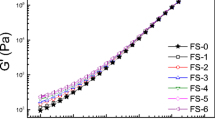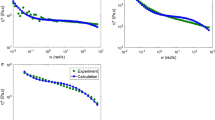Abstract
The influences of interfacial tension and compressibility to the linear viscoelastic properties of nanocomposite and nanoporous materials are considered theoretically. The effective bulk and shear moduli of the systems are calculated within the generalized composite sphere model which takes into account the effect of interfacial tension. It is found that frequency dependence of the effective dynamic shear and bulk moduli of nanocomposites with the compressible elastic matrix and viscous inclusions may be represented in terms of the Zener model comprising of the viscoelastic Kelvin element in series with the elastic spring. The relations of the Zener model parameters with the material characteristics are revealed. The physical interpretation of the frequency behavior of the dynamic shear and bulk moduli against the interfacial tension, component compressibility, viscosity, and inclusion volume fraction is discussed.








Similar content being viewed by others
References
Ballauff M, Lu Y, Christian DA, Discher DE (2007) “Smart” nanoparticles: preparation, characterization and applications. Polymer 48:1815–1823
Bousmina M (1999) Effect of interfacial tension on linear viscoelastic behavior of immiscible polymer blends. Rheol Acta 38:251–254
Chen J, Park H, Park K (1999) Synthesis of superporous hydrogels: hydrogels with fast swelling and superabsorbent properties. J Biomed Mater Res 44:53–62
Christensen RM (1979) Mechanics of composite materials. Wiley, New York
Dou H, Jiang M, Peng H, Chen D, Hong Y (2003) pH-dependent self-assembly: micellization and micelle-hollow-sphere transition of cellulose-based copolymers. Angew Chem 42:1516–1519
Graebling D, Muller R, Palierne JF (1993) Linear viscoelastic behavior of some incompressible polymer blends in the melt. Interpretation of data with a model of emulsion of viscoelastic liquids. Macromolecules 26:320–329
Hashin Z (1962) The elastic moduli of heterogeneous materials. J Appl Mech 29:143
Jang J, Bae J (2005) Fabrication of mesoporous polymer using soft template method. Chem Commun 1200–1202
Jeong U, Ryu DY, Kim JK, Kim DH, Russell TP, Hawker CJ (2003) Volume contractions induced by crosslinking: a novel route to nanoporous polymer films. Adv Mater 15:1247–1250
Kabiri K, Zohuriaan-Mehr MJ, Park K (2004) Porous superabsorbent hydrogel composites: synthesis, morphology and swelling. Macromol Mater Eng 289:653–661
Kim D, Park K (2004) Swelling and mechanical properties of superporous hydrogels of poly(acrylamide-co-acrylic acid)/polyethylenimine interpenetrating polymer networks. Polymer 45:189–196
Krause B, Diekmann K, van der Vegt NFA, Wessling M (2002) Open nanoporous morphologies from polymeric blends by carbon dioxide foaming. Macromolecules 35:1738–1745
Li Q, Quinn JF, Caruso F (2005) Nanoporous polymer thin films via polyelectrolyte templating. Adv Mater 17:2058–2062
Likos CN (2006) Soft matter with soft particles. Soft Matter 2:478–498
Liu L, Li P, Asher SA (1999) Entropic trapping of macromolecules by mesoscopic periodic voids in a polymer hydrogel. Nature 397(6715):141–144
Meier W (2000) Polymer nanocapsules. Chem Soc Rev 29:295–303
Milao D, Knorst MT, Richter W, Guterres SS (2003) Hydrophilic gel containing nanocapsules of diclofenac: development, stability study and physico-chemical characterization. Pharmazie 58:325–329
Nayak S, Lyon LA (2005) Soft nanotechnology with soft nanoparticles. Angew Chem 44:7686–7708
Oldroyd RG (1953) The elastic and viscous properties of emulsions and suspensions. Proc R Soc Lond A 218:122
Omidian H, Rocca JG, Park K (2005) Advances in superporous hydrogels. J Control Release 102:3–12
Pal R (2002) Novel shear modulus equations for concentrated emulsions of immiscible elastic liquids with interfacial tension. J Non-Newton Fluid Mech 105:21–33
Palierne JF (1990) Linear rheology of viscoelastic emulsions with interfacial tension. Rheol Acta 29:204–214
Patel F, Amiji MM (1996) Preparation and characterization of freeze-dried chitozan-poly (ethylene oxide) hydrogels for site-specific antibiotic delivery in stomach. Pharm Res 13:588–593
Raman VI, Palmese GR (2005) Nanoporous thermosetting polymers. Langmuir 21:1539–1546
Sahiner N, Alb AM, Graves R, Mandal T, McPherson GL, Reed WF, John VT (2007) Core-shell nanohydrogel structures as tunable delivery systems. Polymer 48:704–711
Sayil C, Okay O (2001) Macroporous poly(N-isopropyl)acrylamide networks: formation conditions. Polymer 42:7639–7652
Seki K, Komura S (1995) Viscoelasticity of vesicle dispersions. Physica A 219:253–289
Shermergor TD (1977) Elastic theory of micro-heterogeneous materials. Nauka, Moscow
Zhang J-T, Cheng S-X, Huang S-W, Zhuo R-X (2003) Temperature sensitive poly(N-isopropylacrylamide) hydrogels with macroporous structure and fast response rate. Macromol Rapid Commun 24:447–451
Acknowledgments
This work was partially supported by the Russian Foundation of Basic Research (Grant No. 06-03-32208-а).
Author information
Authors and Affiliations
Corresponding author
Additional information
Victor G. Oshmyan deceased.
Appendix
Appendix
The components of the stress tensor can be obtained by substitution of Eqs. 1, 19, and 20 to the relationship \(\sigma _{kl} = C_{klpq} \varepsilon _{pq} \). In the arbitrary point of the shell, they can be represented as follows:
In the inclusion, the stresses are:
Substitution of Eqs. 14, 32, and 33 to the boundary conditions 12 and 13 gives the following set of equations for the unknown coefficients \(A_p^{\left( m \right)} \) and \(A_p^{\left( i \right)} \):
Further calculation of the effective shear modulus with help of Eq. 17 requires only three coefficients, \(A_1^{\left( m \right)} \), \(A_2^{\left( m \right)} \), and \(A_3^{\left( m \right)} \). The solution of Eq. 34 gives:
where \(D^{\left( m \right)} \) satisfies the following expression:
Substituting Eqs. 35, 36, and 37 to Eq. 23 we arrive at Eq. 24 with the following notations:
Rights and permissions
About this article
Cite this article
Oshmyan, V.G., Patlazhan, S.A. & Khokhlov, A.R. Linear rheology of compressible soft nanocomposites. Rheol Acta 47, 359–368 (2008). https://doi.org/10.1007/s00397-008-0270-7
Received:
Revised:
Accepted:
Published:
Issue Date:
DOI: https://doi.org/10.1007/s00397-008-0270-7




